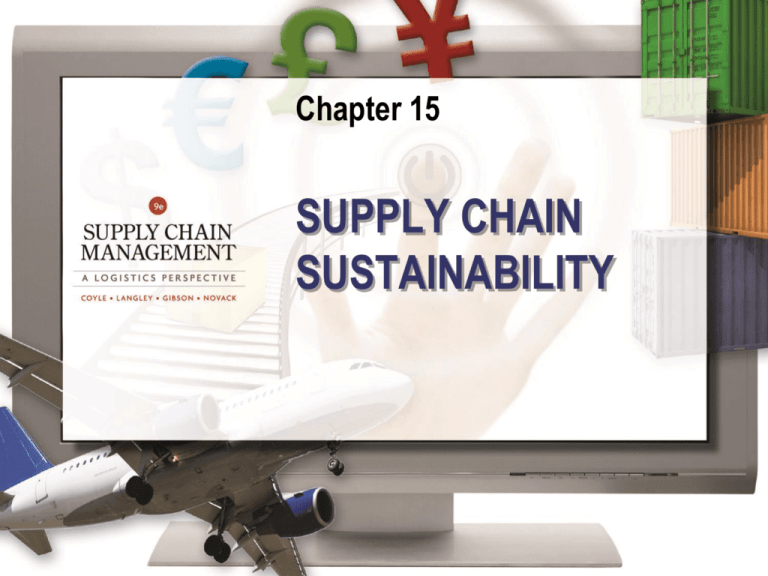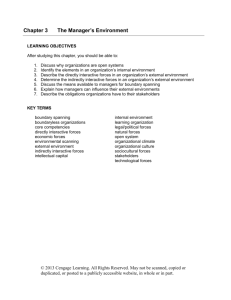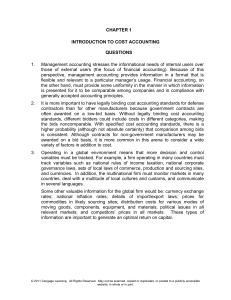
Chapter 15
SUPPLY CHAIN
SUSTAINABILITY
Learning Objectives
After reading this chapter, you should be able to do the following:
● Appreciate the importance of sustainable
supply chains for the protection of the
ecology of the planet.
● Understand how effective supply chain
management can contribute to
sustainability.
● Discuss why it is economically and
politically important to manage supply
chains as sustainably as possible.
©2013 Cengage Learning. All Rights Reserved. May not be scanned, copied or duplicated, or posted to a publicly accessible website, in whole or in
part.
2
Learning Objectives, continued
● Appreciate why sustainability and social
responsibility are the “new normal” for
managing supply chains.
● Understand the established frameworks
for sustainable supply chains.
● Discuss the importance and challenges of
reverse flows in supply chains.
● Understand why there has been a
significant increase in the number and
volume of items moving in reverse flows
and supply chains.
©2013 Cengage Learning. All Rights Reserved. May not be scanned, copied or duplicated, or posted to a publicly accessible website, in whole or in
part.
3
Learning Objectives, continued
● Understand the three major forces that
drive reverse supply chains and the eight
major categories of reverse flows
● Appreciate the differences between
reverse logistics systems and closed-loop
supply chains as well as value streams
and waste streams for reverse logistics.
©2013 Cengage Learning. All Rights Reserved. May not be scanned, copied or duplicated, or posted to a publicly accessible website, in whole or in
part.
4
Supply Chain Sustainability Framework
● Sustainability practices promote harmony
between the industrial system and nature.
● The top sustainability priority is to reduce
carbon footprint
©2013 Cengage Learning. All Rights Reserved. May not be scanned, copied or duplicated, or posted to a publicly accessible website, in whole or in
part.
5
Supply Chain Sustainability Framework
● Green SCM means green purchasing, mfg., distribution,
and reverse logistics.
● Sustainability integrates three Ps (profit, people, and
planet).
● Sustainability considers the entire life cycle of the
products in the SCM including product design, material
sourcing, mfg., delivery, operations, and disposal.
● Sustainable means “do no harm to the natural and social
systems, while still making a profit over an extended
period of time.
● Sustainable market framework:
• Reduce surplus supply in the SC (no over production)
• Reduce reverse supply (reparable, recyclable, re-mfg., etc)
©2013 Cengage Learning. All Rights Reserved. May not be scanned, copied or duplicated, or posted to a publicly accessible website, in whole or in
part.
6
Sustainability Approaches
● Re-use
● Re-manufacturing
● Re-conditioning
● Recycling
©2013 Cengage Learning. All Rights Reserved. May not be scanned, copied or duplicated, or posted to a publicly accessible website, in whole or in
part.
7
Reverse Logistics Systems
● Reverse flows are goods and materials moving
upstream in the supply chain.
● Reverse flows were traditionally ignored, but regulation
and economics have increased attention on them.
● Traditionally, reverse flows were not viewed as adding
value for customers or revenue for the manufacturer or
producer.
● Information and financials (cash) are important
dimensions of reverse logistics and closed loop supply
chains.
● Global supply chains present challenges and
opportunities for reverse flows Including green laws.
©2013 Cengage Learning. All Rights Reserved. May not be scanned, copied or duplicated, or posted to a publicly accessible website, in whole or in
part.
8
Importance and Magnitude of Reverse
Flows
● Estimates are that returns range from 3 –
50% depending on the product.
● Retailers lose 3 to 5% of gross sales to
returns, accounting for about 4.5% of the
cost of logistics.
● Internet returns are about double the
counter sale returns.
©2013 Cengage Learning. All Rights Reserved. May not be scanned, copied or duplicated, or posted to a publicly accessible website, in whole or in
part.
9
Importance and Magnitude of Reverse Flows, continued
● Eight categories of reverse flows
1.
2.
3.
4.
5.
6.
7.
8.
Products that have failed; are unwanted, damaged, or defective;
but can be repaired or remanufactured and resold.
Products that are old, obsolete, or near the end of their shelf life
but still have some value for salvage or resale.
Products that are unsold from retailers, usually referred to as
overstocks that have resale value.
Products being recalled due to a safety or quality defect that may
be repaired or salvaged.
Products needing “pull and replace” repair before being put back in
service.
Products that can be recycled such as pallets, containers,
computer inkjet cartridges, etc.
Products or parts that can be remanufactured and resold.
Scrap metal that can be recovered and used as a raw material for
further manufacturing.
©2013 Cengage Learning. All Rights Reserved. May not be scanned, copied or duplicated, or posted to a publicly accessible website, in whole or in
part.
10
Reverse vs. Closed-Loop Logistics
Systems
● Reverse logistics—The process of moving or
transporting goods from their final destination for
the purpose of capturing value or for proper
disposal.
• Reserve logistics involves the processes for sending new
or used products “back up stream” for repair, reuse,
refurbishing, resale, recycling, or scrap/salvage.
● Closed loop supply chains—Designed and
managed to explicitly consider both forward and
reverse flows activities in a supply chain.
• Explicitly designed and managed for both flows
©2013 Cengage Learning. All Rights Reserved. May not be scanned, copied or duplicated, or posted to a publicly accessible website, in whole or in
part.
11
Figure 15.1
Closed Loop Supply Chain for Cartridges
Source: Center for Supply Chain Research, Penn State University.
©2013 Cengage Learning. All Rights Reserved. May not be scanned, copied or duplicated, or posted to a publicly accessible website, in whole or in
part.
12
Figure 15.3
Closed Loop Supply Chain for Tire Retreading
Source: Center for Supply Chain Research, Penn State University.
©2013 Cengage Learning. All Rights Reserved. May not be scanned, copied or duplicated, or posted to a publicly accessible website, in whole or in
part.
13
Reverse Logistics vs. Closed Loops, continued
● Customer Returns
• A variety of reasons for customer returns can be
given (as indicated previously) including defective or
unwanted items, warranty problems, recalls, and
miss-shipments.
● Environmental Challenges
• Recycling and environmental concerns are frequently
viewed simultaneously because of their association
with regulatory policy at the local, state, and/or federal
level.
©2013 Cengage Learning. All Rights Reserved. May not be scanned, copied or duplicated, or posted to a publicly accessible website, in whole or in
part.
14
Reverse Logistics vs. Closed Loops, continued
● Economic Value
• Value has become an important for businesses and
even some nonprofit organizations.
● Making reverse flows profitable is a
challenge as well as an opportunity.
©2013 Cengage Learning. All Rights Reserved. May not be scanned, copied or duplicated, or posted to a publicly accessible website, in whole or in
part.
15
Achieving a Value Stream for Reverse
Flows
● Barriers to implementing a reverse flows system
(which could be internal or external):
• Lack of “buy-in” from top level management in the
•
•
•
•
organization
Priority relative to other issues and potential projects
or programs in the organization
Financial resources necessary for operations and
asset infrastructure
Personnel resources required to develop and
implement the reverse flows program
Adequacy of material and information systems to
support the returns program
©2013 Cengage Learning. All Rights Reserved. May not be scanned, copied or duplicated, or posted to a publicly accessible website, in whole or in
part.
16
Managing Reverse Flows in a Supply
Chain
Recommendation by the Reverse Logistics Educational Council:
● Avoidance—Producing high-quality products and developing
processes to minimize or eliminate returns
● Gatekeeping—Checking and screening merchandise at the entry
point into the reverse flows process to eliminate unnecessary
returns or minimize handling
● Reducing reverse cycle times—Analyzing processes to enable
and facilitate compression of time for returns to enhance value
recapture
● Information systems—Developing effective information systems to
improve product visibility, reduce uncertainty, and maximize
economies of scale.
● Returns centers—Developing optimum locations and facility
layouts for returns centers to facilitate network flow
©2013 Cengage Learning. All Rights Reserved. May not be scanned, copied or duplicated, or posted to a publicly accessible website, in whole or in
part.
17
Managing Reverse Flows in a Supply Chain, continued
Recommendations by the Reverse Logistics Educational Council:
● Asset recovery—Classifying and disposing of returned items,
surplus, scrap, and obsolete items to maximize returns and minimize
cost
● Pricing—Negotiating the best price for products being returned and
resold
● Outsourcing—Considering a relationship with a third-party
organization to handle and manage reverse flows in cases where
existing personnel, infrastructure, experience, and/or capital may not
be adequate to implement a successful program
● Zero returns—Developing a policy to exclude returns by giving a
returns allowance and/or “destroying” the product in the field
● Financial management—Developing guidelines and financial
procedures to properly account for charges against sales and
related financial issues when items are returned by customers
©2013 Cengage Learning. All Rights Reserved. May not be scanned, copied or duplicated, or posted to a publicly accessible website, in whole or in
part.
18
Summary
● Sustainability has become an increasingly important
objective for private-sector for-profit organizations in the
twenty-first century.
● Initially organizations focused upon sustainability
because of political and public pressure and their
recognition of the importance of their social
responsibility.
● In recent years there has been a growing recognition of
the economic opportunity to reduce cost and improve
profit positions.
©2013 Cengage Learning. All Rights Reserved. May not be scanned, copied or duplicated, or posted to a publicly accessible website, in whole or in
part.
19
Summary, continued
● Sustainability is a challenging and complex issue
because of the diversity of views on the topic, but some
supply chain professionals have found it useful to
consider sustainability on a broad functional basis—
inbound functions, production and operation functions,
and outbound or distribution functions.
● Transportation is frequently a critical part of a
sustainability effort since it has the potential of leaving
such a large carbon footprint. Various transportation
strategies that are both cost efficient and ecologically
sound can be used to mitigate this challenge.
● The so-called R’s of sustainability include: reuse,
remanufacturing, refurbishing, and recycling. The R’s are
unique but can be used in a comprehensive program
where they are complimentary to each other.
©2013 Cengage Learning. All Rights Reserved. May not be scanned, copied or duplicated, or posted to a publicly accessible website, in whole or in
part.
20
Summary, continued
● The R’s can be an important component of a recycling
program to create a value stream for the organization to
enhance profitability.
● Recycling is often part of a reverse flow logistics system
or closed-loop logistics system, and both have grown in
importance as reverse flow volumes have increased
during the last two decades.
● The major forces impacting the growth in reverse flow
volumes have been customer returns, environmental
policies, and economic benefits for organizations.
● When designing an efficient and effective returns flow
program, consideration must be given to the variety of
the returns and the development of procedures and
processes for each one.
©2013 Cengage Learning. All Rights Reserved. May not be scanned, copied or duplicated, or posted to a publicly accessible website, in whole or in
part.
21
Summary, continued
● An analysis of the benefits of a reverse or return flows
program is dependent upon the development of the true
costs associated with such a program and comparing
them to a realistic measure of the benefits.
©2013 Cengage Learning. All Rights Reserved. May not be scanned, copied or duplicated, or posted to a publicly accessible website, in whole or in
part.
22









